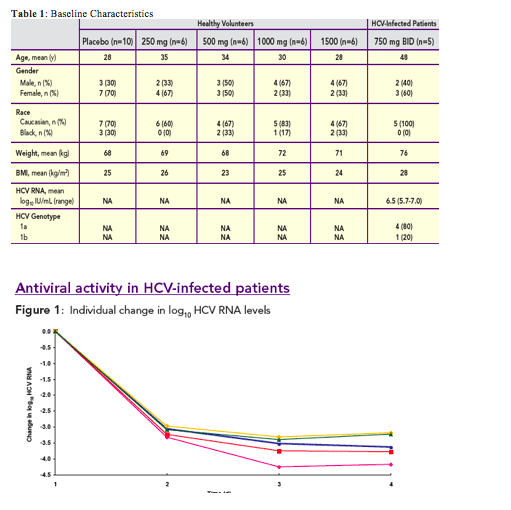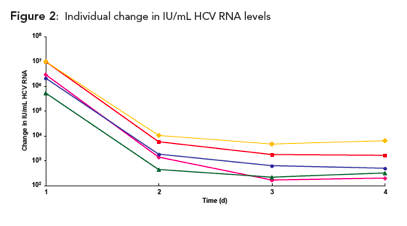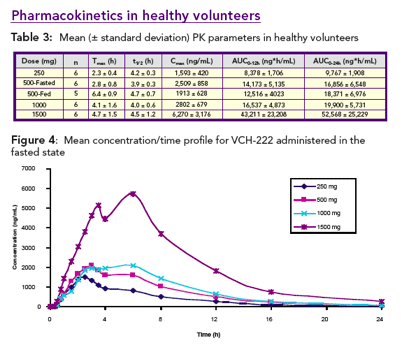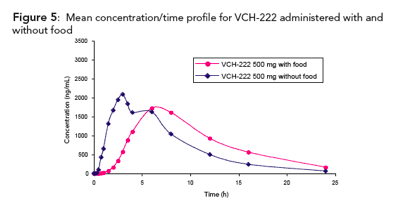 |
 |
 |
| |
Safety, Tolerability and Pharmacokinetics of the HCV Polymerase Inhibitor VCH-222 Following Single Dose Administration in Healthy Volunteers and Antiviral Activity in HCV-infected Individuals
|
| |
| |
44th EASL April 23-26 Copenhagen
Reported by Jules Levin
C. Cooper1, R. Larouche2, B. Bourgault3, N. Chauret3, L. Proulx3
1The Ottawa Hospital, Ottawa, ON, Canada; 2Anapharm - a Pharmanet company, Montreal, QC, Canada; 3ViroChem Pharma Incorporated, Laval, QC, Canada
Supported by ViroChem Pharma Incorporated, a wholly-owned subsidiary of Vertex Pharmaceuticals Incorporated
AUTHOR CONCLUSIONS
VCH-222 was well tolerated at up to 1500 mg when administered as single oral doses to healthy volunteers and well tolerated at 750 mg bid over 3 days of treatment in HCV patients.
All patients experienced a >3 log10 reduction in plasma HCV RNA after 24 h of treatment. A mean maximal reduction of 3.7 log10 in HCV RNA was observed after 3 days of treatment at 750 mg bid.
No virologic rebound was observed during treatment. Sequencing of viral isolates is ongoing.
A Phase II study has been initiated to determine the optimal dosing regimen for VCH-222.
BACKGROUND
HCV is a debilitating human pathogen affecting an estimated 3% of the world'spopulation. Current therapies are associated with limited efficacy and severe adverse side effects.1,2 Therefore, the development of new safe and effective HCV-specific anŽtiviral agents is needed to alleviate this serious health problem.
The RNA-dependent RNA polymerase (NS5B) from HCV is a key enzyme in HCV replicaŽtion and is a major target for the development of antiviral compounds against HCV.3
VCH-222, a thiophene 2-carboxylic acid derivative, is a novel non-nucleoside HCV RNA polymerase inhibitor, with low micromolar antiviral activity against HCV RNA polyŽmerase genotype 1a and 1b in the replicon assay.4
OBJECTIVES
To evaluate the safety, tolerability and pharmacokinetics (PK) of VCH-222 in healthy volunteers with single ascending doses.
To study the antiviral activity, safety and PK of VCH-222 administered as monotherapy over 3 days in patients with genotype 1 HCV infection.
METHODS
Study Design (Cohorts I to IV) - Healthy Volunteers: The study is a double-blind, placebo-controlled, single dose-escalating (250, 500 [with and without food], 1000 and 1500 mg) study, with a crossover food effect in male and female healthy volunteers. 6 active and 2 placebo subjects per cohort.
Study Design (Cohort V) - Genotype 1 HCV-infected Patients: Open-label, single-dose (750 mg bid) monotherapy study over 3 days in 5 treatment-naïve patients with chronic hepatitis C infection.
Pharmacokinetic Analysis: Serial blood samples were collected for up to 24 h and VCH-222 was analyzed using a validated LC/MS/MS assay.
HCV RNA Analysis: Performed using Roche Cobas TaqMan HCV RNA v.2 assay (LOD <15 IU/mL).
Safety Assessments: Physical examination, vital signs, hematology, blood biochemisŽtry, urinalysis, ECGs and adverse events (AEs) assessments were performed throughout the study.
RESULTS
No notable differences were observed among treatment groups or between subjects who received active treatment versus placebo with respect to demographic parameters.


All 5 HCV genotype 1 patients demonstrated rapid and significant antiviral response, with >3 log10 reduction in plasma HCV RNA after 24 h of treatment. A mean maximal reduction in plasma HCH RNA of 3.7 log10 was observed over the 3 days of treatment.
No virological rebound was observed during this 4 day treatment period.
Same response was observed in the 4 genotype 1a patients and in the genotype 1b patient.

The rate and extent of absorption (Cmax, AUC) in patients receiving 750 mg of VCH-222 (first administration) was similar to those observed in the healthy volunteers who were administered 1500 mg VCH-222.
The trough plasma levels measured at day 4, for each patient, were between 8 and 24-fold above the adjusted IC90 values calculated from the replicon assay (319 ng/mL).

Under fasting conditions, the rate and extent of absorption (Cmax, AUC) appeared to be proportional to dose in the dose-range of 250 to 1500 mg except for the 1000 mg dose

With regard to food-effect, the extent of absorption remained unaffected in the fed state when compared to the fasted state, however, there was a modest decrease in the rate of absorption (Cmax) and a significant delay in absorption (Tmax) when VCH-222 was administered with a high-fat meal.

REFERENCES
1. Washley A; Alter MJ. Epidemiology of hepatitis C: geographic differŽences and temporal trends. Semin. Liver Dis. 2000;20:1-16.
2. Fried MW; Shiffman ML; Reddy KR; et al. Peginterferon alfa-2a plus riboŽvirin for chronic hepatitis C virus infection. NEJM 2002;347:975-82.
3. De Francesco R; Tomei L; Altamura S; et al. Approaching a new era for hepatitis C virus therapy: inhibitors of the NS3-4A serine protease and the NS5B RNA-dependent RNA polymerase. Antiviral Res 2003;58:1-16.
4. Bedard J; Nicolas O; Bilimoria D; et al. Identification and characterizaŽtion of VCH-222, a novel potent and selective non-nucleoside HCV polyŽmerase inhibitor. 44 th EASL conference, Copenhagen, Denmark, 2009. Abstract 935.
|
| |
|
 |
 |
|
|